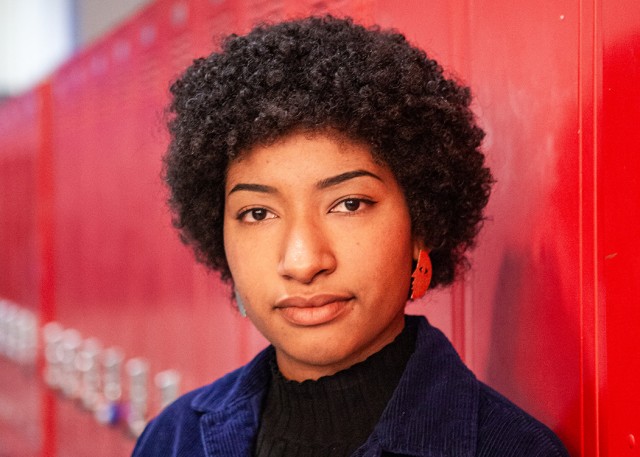Claudia Rodriguez’s senior thesis film has art lovers sniffing drugs off priceless works.
The fourth-year film student said she brainstormed the premise for her film “Illegal Artist” after burrowing deep into assorted Wikipedia articles on obscure artists. After spiraling through a variety of articles, Rodriguez said she was inspired to write a clear narrative surrounding the struggle minorities face in the world of art. She said her trip into the depths of Wikipedia helped her generate themes that tackle art and its commercialization in the film, which will be shot over the weekend.
“The way I came up with (the idea) was super weird,” Rodriguez said. “I clicked on some random artist on Wikipedia and just thought, ‘Why do we have to use art to get money?’ … I started brainstorming ideas until I came up with lacing (art) with a foreign kind of drug to create interest.”
[Related: Student’s short film champions putting self first over societal pressures]
Eventually, Rodriguez said her ideas culminated in a fictional drug called Influence, which causes people to alter their original opinions regarding objects it is applied to. Her main protagonist, Marcus, is a black artist who is struggling with the gentrified gallery scene. Hoping to invert the current power structure that inhibits minority artists from making a living off their passion, Marcus sprays the drug on his pieces to hook or intoxicate the viewers. But Rodriguez said his plan goes awry when the effects yield unexpected consequences.
Once Influence is applied to Marcus’ work, viewers suddenly begin to fawn over him and his art. Fourth-year film student Emile Caton said Rodriguez’s critique of the art world initially drew him to the project. The drug has changed their perceptions of his pieces to match their personal tastes and completely disregards Marcus’ artistic voice, which Caton said comments on the perception of both art and artist.
“It’s an incredibly interesting topic about people’s perception of art and how society tends to put a lot of emphasis on the meaning of a piece derived from that artist’s particular background,” Caton said. “She’s challenging that in her art by having hallucinogenic paintings (alter) people’s perceptions.”
With her thesis film, Rodriguez said her vision is to convey key themes of identity and perception. She said her work subtly infuses the message that people of color and minorities are multidimensional, as opposed to the surface-level labels that they are perceived as. In an early scene of the film, the gallery owners critique Marcus’ work, claiming he is not expressing his “true” artistic voice and that his work is derivative.
“They’re basically saying that because they can’t profit off of his voice, he’s a repeat of the talent that they already have from white men,” Rodriguez said. “They want to profit off of his racial perspective rather than his genuine multidimensional perspective.”
[Related: UCLA Film & Television Archive showcases 40 years of student filmmaking]
Furthermore, Rodriguez said her project seeks to confront the pressure to conform and fit into profitable stereotypes. The film’s foundation is Marcus’ struggle to choose between being defined by his race as an artist and his ability to express his individuality at the cost of possible failure, she said. In the film, Marcus’ plan backfires when Influence causes the viewers to see his work as what they wanted it to be in the first place: a shallow expression of his racial identity.
“Now they’re objectifying him as a black person by saying, ‘Wow, this has so much history, brother. It’s so powerful,’” Rodriguez said. “It’s (making him a novelty) in a comedic way, but if you know that perspective, it’s deeply uncomfortable. … It’s subtext, but you can tell that this is the way that black people are treated. They’re just writing over what they see in his art and speaking over his own artistic voice.”
While “Illegal Artist” is still in its early stages, Rodriguez’s advocacy for diversity and empathy within the art community has started long before her work on the film, said Gabrielle Gorman, a fourth-year film major and the first assistant director. When the two initially met last year, Gorman said they connected over their shared vision for a more inclusive film industry. She said the film’s critiques of the industry are subtly executed, rather than blatantly obvious, which prompts the audience to do its own thinking.
“She spoke very passionately about how frustrating it can be as an artist of color to feel like your work is being policed or feel like there’s so much pressure to represent an entire community,” Gorman said. “That’s a message that I know she feels really strongly about showing in this piece.”
Rodriguez views her film as a true passion project that has the potential to bring her audience together, she said. Despite the pressure to perform, Rodriguez said she has worked toward overcoming the anxiety associated with it in order to produce a project she is proud of and express the themes of perception and identity she feels so strongly about.
“I want to show the importance of identity, representation and art,” Rodriguez said. “The script is coming straight from who I am and how I feel about society. … (Hopefully that) resonates with other people.”

